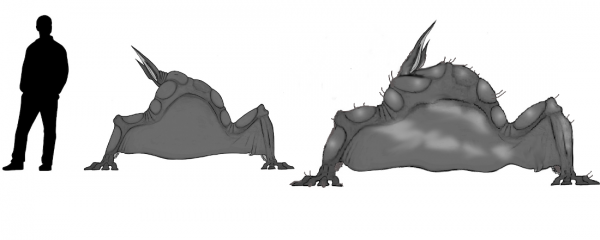BY LETTER
First Plague, The (To'ul'h Prime)
 Image from Steve Bowers adapted from original by Andrew P | |
| Giant To'ul'h race compared to a Common To'ul'h and a human baseline | |
The First Plague (also known as the Xenoplague, or the Exodemic) was a virus on the planet Tohul, home of the xenosophont To'ul'hs. The First Plague appeared c. 182,000 years BT, more than one hundred thousand years before the appearance of the first urban societies, and is easily the most catastrophic event to affect the To'ul'h species, above even the 'Thass'thon' Eruption in terms of total deaths. Xenologists have speculated that the virus was initially transmitted via physical contact, but later became airborne, spreading across all six continents. The First Plague is blamed for the extinction of at least two races of To'ul'h, and very nearly causing the extinction of the giant To'ul'h race1, which is suspected to have recovered from a population in the double-digits. Because of the immense time scales involved, as well as the pre-contact To'ul'hs lacking the equipment required for advanced archaeology, the Plague's existence was entirely unknown to the To'ul'hs until contact with Terragens, who had become aware of the Plague while researching the species' history.
However, it should be noted that there have been at least two occasions where the skeletal remains of First Plague victims were recovered by To'ul'hs. The 'Nal' civilisation is known to have discovered what they believed to be the skeleton of a demon from the summit of Mt. 'Thass'thon'2, which was taken for study, although ultimately abandoned, apparently due to a series of misfortunes affecting clerics. This skeleton would be uncovered by Terragens many millennia later, where it was discovered to have several 'Nal' religious objects shoved between its bones, presumably to prevent it from returning to life. The First World State, which appeared only a short time after the 'Nal' civilization, are also known to have found a similar skeleton. Studied by To'ul'h scientists, some claimed the skeleton to be definitive proof of the existence of "sky islands", and their demon inhabitants. One unnamed cult devoted to such demons is noted to have unsuccessfully attempted to remove the item from containment.
The First Plague has been of particular interest to xenologists, due to its peculiar origins, in that it is an example of a very rare phenomenon, known as panspermia. The First Plague is suspected to have been brought to Tohul via asteroid, a hypothesis supported by the Pan'bo Crater, an impact crater located in what is now northern The'hia on the continent of Kansho. This crater, which measures roughly 0.8 km in diameter, has been dated to roughly the same time as the First Plague's initial appearance.
The First Plague has also been of interest to the general public. The remains of First Plague victims tend to be almost Lovecraftian in appearance, and after Terragen Contact, the First Plague was featured in many early To'ul'h virches. Although some such virches attempt to remain realistic, others often place the First Plague in other timeframes, such as the Second World State Period, or the late Pre-Contact Epoch. Many virches also offer more fantastical explanations for the Plague's appearance, from being created by mad scientists and dark magicians to aliens and time travelers.
Footnotes
[1]. Modern To'ul'hs consist of giant, average, and pygmy races. The fact that giant To'ul'hs survived until Terragen contact is almost miraculous, and when contact was made, the species was again in decline, with less than ten thousand giant To'ul'hs worldwide, mostly dwelling in the few tribes of eastern Thi'tha.↩[2]. The 'Nal' believed that Tohul had been created by the Mother Abyss (Po'tel Abyss), and that her evil sister, Mt. 'Thass'thon', was the creator of all evil in the world.↩
Related Articles
Appears in Topics
Development Notes
Text by James Rogers
Initially published on 08 August 2016.
Initially published on 08 August 2016.






